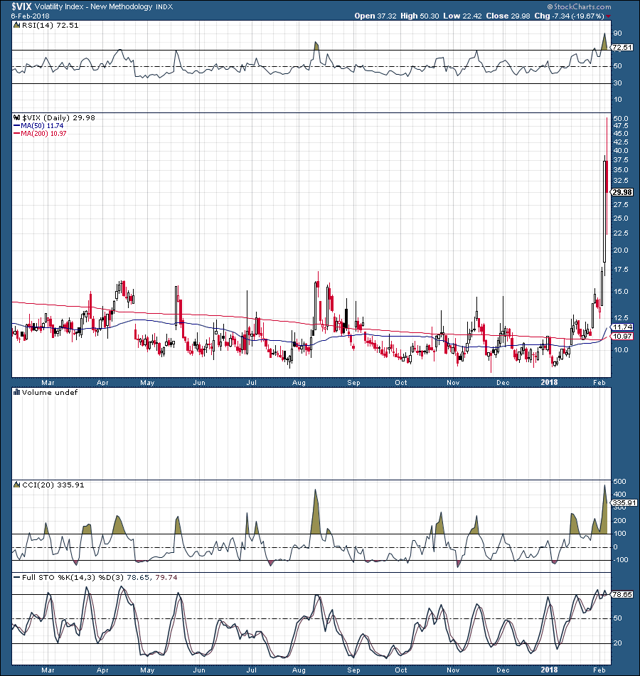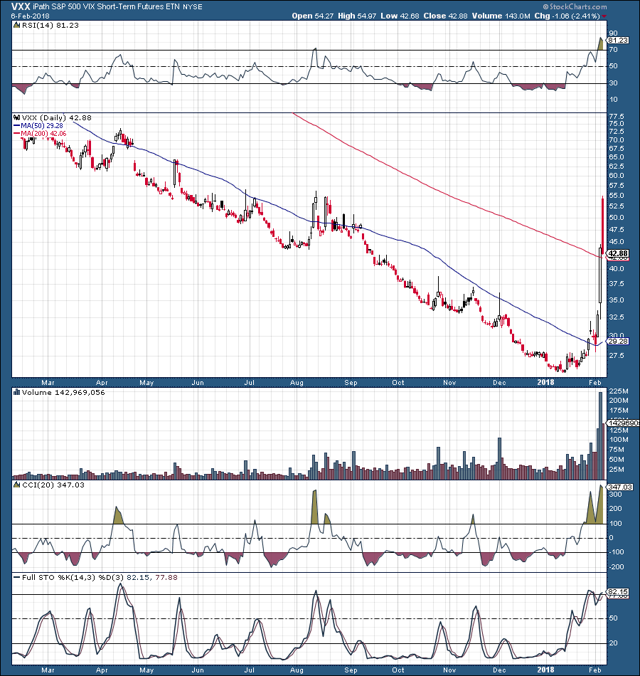[ad_1]

Source: Dailymirror.com
Almost everything is selling off, the dollar, bonds, stocks, even Bitcoin and cryptocurrencies. The bond selloff coupled with the dollar weakness is trying to tell market participants something, and investors are selling everything. Market participants appear to be moving into cash, as the vicious stock market selloff erases months of gains in a matter of days.
The SPDR S&P 500 ETF (SPY) had one of its worst days on record, dropping more than 100 points, over 4%, erasing gains from the last 2 months. Overall, the S&P is now down by roughly 10% from its all-time highs reached about a week ago. At the same time the VIX unwind has been staggering. The VIX has more than quintupled in the last weeks, and at the time of writing this article was at 50, a level not seen since the height of the 08-financial crisis. Moreover, the iPath S&P 500 VIX ST Futures ETN (VXX) is up by an unprecedented 100% over the past few sessions, as the breathtaking VIX unwind progresses.
Panic is clearly present, and a few crucial questions are on market participants’ minds. How long will this carnage in stocks last? Is this the beginning of a bear market? Will stocks continue to crash? Will volatility continue to surge? Or is this a “healthy” correction ready to present outstanding buying opportunities?
This article will focus on a few ETFs, so I provided some background information on the instrumental ones below for reference.
About SPY
SPY is the first major and most popular ETF in the world. It’s designed to mimic the exact movement of the S&P 500. The SPY Index fund has roughly $277 billion in net assets, and each share in the fund represents a fraction of the holdings. SPY provides investors with exposure to the S&P 500 index, which is widely regarded as the most significant stock market average for U.S. equities. Since SPY tracks the exact movements of the S&P 500 I will use SPY and the S&P 500 interchangeably throughout the article.
About VXX
VXX is designed to provide access to S&P 500 volatility through CBOE Volatility Index (the VIX Index) futures. The ETN offers exposure to a daily rolling long position in the first and second-month VIX futures contracts and reflects market participants’ views of the future direction of the VIX index at the time of expiration of the VIX futures contracts comprising the Index.
(VXX decays heavily over time due to contango and does not generally make for an efficient long-term trading vehicle. Therefore, VXX is designed primarily for short-term trading and has proven to be a profitable tool for shorting volatility.)
The Inflation, Dollar, Bond, and Fed Dynamic
The first thing we should discus is the likely source of this selloff, the bond, dollar, and Fed dynamic. It is true that a weak dollar is somewhat positive for the economy, as a cheap dollar makes our goods more competitive overseas, and should increase corporate profits. However, from a macro view it makes it less favorable for market participants to hold U.S. debt, and this is especially troubling now that the U.S. is faced with expanding trade deficits, and a ballooning budget deficit, coupled with bond selling from the Fed and other major market participants. Moreover, the dollar is not just down a few percent in the last year, but is down 15%, which is quite substantial and worrisome to an extent. The main culprit behind the dollar’s decline is inflation. Recent figures suggest inflation is heating up and will likely continue to get hotter.
In conjunction to the steep dollar selloff, bonds have been selling off as well. Subsequently, rates have skyrocketed in recent months, the 10 year is up by roughly 40% since last September, and is up by more than 100% since July of 2016. Higher rates are not good for growth in the economy and the fear is that they are rising not because all is well in economic land, but because inflation is gaining momentum. This would also be consistent with the perpetual decline in the dollar, that it is largely inflation related.
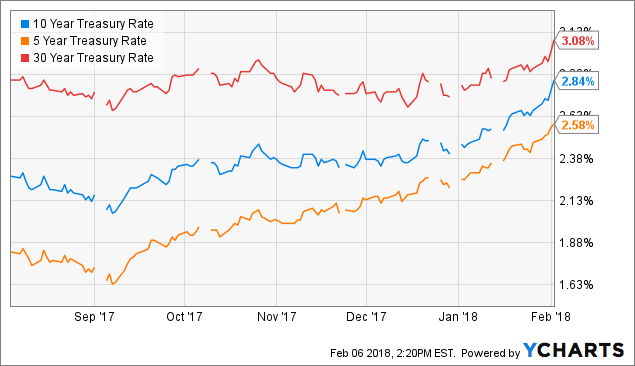
The flattening of the yield curve is also quite troubling. The difference between a 5 year T note and a 30 year T bond is only 0.5%, or half of one percent. Why would anyone want to buy and hold a bond for 25 more years just to make an extra half a percent per year? Especially when the dollar is declining and is likely to continue its decline.
To compound the bond dilemma the Fed is embarking on a quantitative tightening path QT. The Fed will attempt to unwind its massive multitrillion dollar bond portfolio by selling bonds on the open market. It is important to mention that this has never been done before, so it is in essence an economic experiment repercussions of which are unknown.
Another point to consider is that the Fed and China are the two largest holders of U.S. bonds. China has suggested that it will not be purchasing more U.S. debt and the Fed has indicated that instead of buying bonds, it will now be selling them. China may also be selling U.S. bonds instead of buying now. Therefore, the debt market could get flooded with U.S. debt, and the only way to create demand for it with a cascading dollar is for rates to go higher.
Thus, another fear is that the Fed will accelerate the tightening process to curb inflation and to incentivize demand for U.S. bonds. However, we know that higher rates are negative for economic activity and are very damaging for risk assets, stocks in particular. Essentially, this is where the 10% correction in SPY comes from coupled with a 100% rise in VXX.
In summary:
- Inflation is running hotter than expected.
- The dollar is falling.
- Bond rates are still low, most are lower than the true rate of inflation.
- Market participants don’t have a great deal of incentive to buy U.S. bonds.
- To Compound the problem the Fed is beginning to sell bonds.
- The Fed is also raising rates.
- Rates will continue to rise.
- Higher rates are negative for companies.
- Higher rates are negative for economic growth.
- Higher rates will lead to increased borrowing and servicing costs.
- As a result stocks are selling off.
But It’s Not All Bad News
Although the negative headlines are hijacking the news flow for the time being, it’s not all bad news. In fact, the economic landscape still appears quite positive for 2018. Let’s look at some favorable factors surrounding stocks.
Increased Economic Activity: The U.S. economy is doing well, practically firing on all cylinders. Unemployment is low, consumer sentiment is high, and most economic indicators are suggesting strong economic growth will proceed going forward.
GDP Expansion: The U.S. recently clocked in back-to-back 3% plus GDP prints for the first time since the great recession, and Q4 2017 GDP came in at 2.6%. Due to the Tax cuts and other recently implemented economic stimuli robust GDP growth could provide expansion around 3% this year.
Inflation: Inflation is a double edged sword, and along with economic expansion, and growing GDP, inflation is also beginning to rise noticeably. In fact, the PPI’s last reading came in at above 3%, a multi-year high. Moreover, the CPI is trending at above 2%, suggesting that inflation is alive and well in the U.S. economy. Rising oil, gold, and other commodity prices, a falling USD, elevated PPI and CPI are all indications that inflation is here, and is not about to go away any time soon. Increased inflation is good for commodities, and is also favorable for stocks in general, so long as it does not start to interfere with economic growth.
Weak Dollar: Having a weak dollar is not necessarily a negative. A lower dollar makes U.S. companies more competitive abroad and will enable companies to produce higher profits.
Record Corporate Profits: The monetary atmosphere provided by the Fed is still quite easy. This, coupled with robust growth, and a weak dollar creates an ideal environment for corporate profits to expand. Tax cuts will amplify the profit producing effect.
Tax Cuts: No matter how high profits are already, they can always be higher, and that is where tax reform comes in. Corporate tax cuts, repatriation of capital, and other factors will contribute to overall economic activity in the U.S. and should create even greater profits for corporations in 2018.
Positive Sentiment: Despite the recent dent in sentiment investor sentiment is still extremely high. Market participants are still relatively comfortable with the current economic landscape, and a stock market correction should not ruin sentiment over the long term.
Possible Outcomes
1. This is a “healthy” correction that will lead to a buying opportunity.
2. This is the start of something more significant than a simple correction and could lead to a full-blown bear.
So, there are some clear negative economic developments, but there are also many favorable factors for stocks as well. It does not appear that there is a substantial chance for a bear market right now. It is much likelier that the market is simply getting the badly needed correction it has been alluding for many months. Can it get worse? Of course, but is it likely to get much worse than it has already? I don’t think so. A 10 – 15% correction seems to be just what the doctor ordered, and this is what we are seeing right now.
Furthermore, the decline is likely to deter Fed officials from hiking rates at an accelerated pace. The Federal Reserve understands the impact that Fed policy has on stocks and is likely to slow down the rate hike path if further carnage in the stock market is endured. Moreover, this is the first real dip stocks have had in over a year, and there a lot of buyers who want to get into stocks at discounted prices, this may be their chance.
“The Bear” is not here yet, but that doesn’t mean he is not in the process of awaking from hibernation. The underlying inflation, dollar, bond, Fed dynamic is not going to impact the broader economy in the immediate future, but it will eventually. And when it does, the bear is likely to strike stocks with ferocious severity. I expect this to occur sometime in 2019-2020. But until then stock declines are likely to be temporary corrections. I also expect there to be more corrections than market participants have become used to. The era of supper low volatility likely came to an end last week. And although the VIX is likely to drop off significantly from current levels, don’t expect to see a 10 handle on the VIX any time soon.
The Bottom Line: Time to Look for Some Opportunities
The VIX has skyrocketed by 400%, or 5 X over the past few sessions. This level of volatility is simply unsustainable, so naturally it makes sense to short volatility here. One of the best ways to short volatility is by shorting VXX. The best way to short VXX is by selling call options in VXX. Many of the call options going out 2 – 6 months have skyrocketed by 1,000%, some more just in the past two days, and they are simply trading at levels that are unsustainable.
It is extremely likely that these call options will crash by 90% or more over the next few days and weeks. Other similar strategies include buying puts in VXX, and applying similar strategies to (UVXY). However, the trade that will provide the highest returns short term is selling call options in VXX and UVXY.
I Can’t Say I Didn’t Warn You About XIV
It is also possible to go long VIX short products but I must warn of the possible consequences. Trading instruments such as VelocityShares Daily Inverse VIX ST ETN (XIV), and ProShares Short VIX Short-Term Futures (SVXY) that focus on short term VIX futures performed extremely well over the past year. However, as of yesterday they officially broke down due to the massive spike in volatility. Both were trading down by 80 – 90% on Tuesday.
I can’t say I didn’t warn investors, last year I wrote an article on XIV, warning of the possible consequences involved with holding this ETN long term. VelocityShares Daily Inverse VIX MT ETN (ZIV) is another short VIX product but it focuses on medium term futures contracts, not short term ones like XIV and SVXY. Therefore, it should be more insulated from potential breakdowns. Nevertheless, I would still treat this ETN as a short term trading vehicle and not a long term buy and hold.
VIX 1-Year Chart
VXX 1-Year Chart
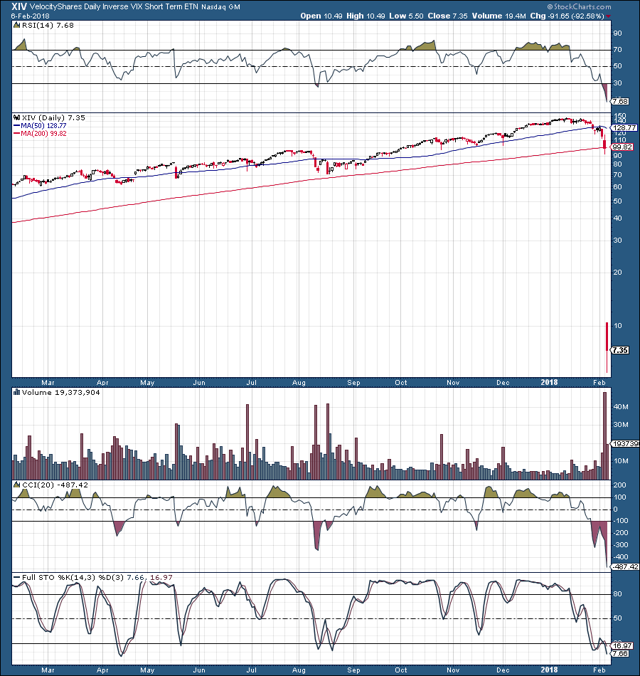
We can see that XIV essentially broke because of the enormous VIX spike.
ZIV 1-Year Chart
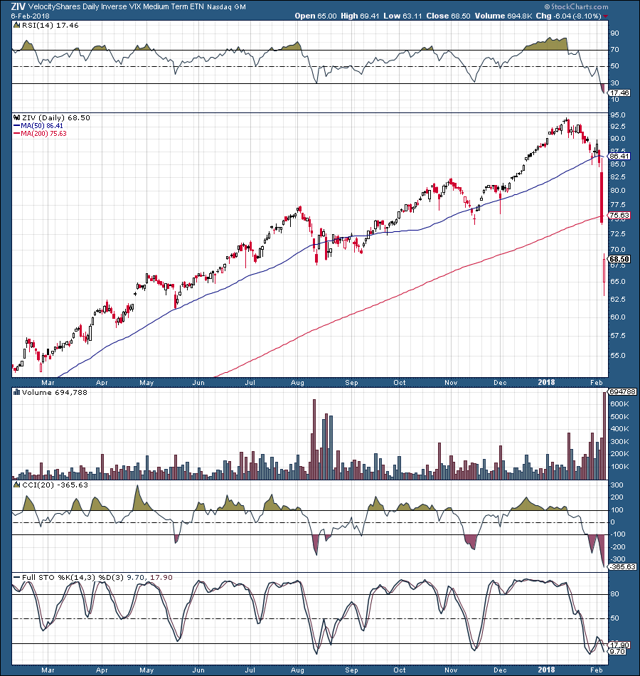
We can see that ZIV is down but not out. It is likely to rebound sharply as the VIX reverts to the mean in the coming days and weeks. Also, due to its structure it does not pose the same threat of “breakdown” as XIV and SVXY did.
Shorting the VIX is just one trade that has an enormously high probability of delivering significant profits in a relatively short time frame. However, this selloff should present several lucrative buying opportunities. The dip buyers are likely to come in strong once it becomes evident that this is a correction and not a recessionary bear market decline.
I expect financials, energy, basic materials, gold, and big tech to do extremely well once stock catch a strong bid. Moreover, these sectors should continue to outperform throughout 2018. Therefore, this temporary decline of 10% – 15% in the S&P should be looked at as an excellent buying opportunity, as stocks are likely to advance higher going forward.
SPY has declined by almost exactly 10% from its all-time high to correction low, before getting bought up aggressively. Also, we can see that the 4% drop came on extremely high volume indicative of a panic selling, capitulation type event. SPY is now drastically oversold in the short-term, suggesting that this correction while steep and violent may not be around for too much longer.
SPY 1-Year Chart
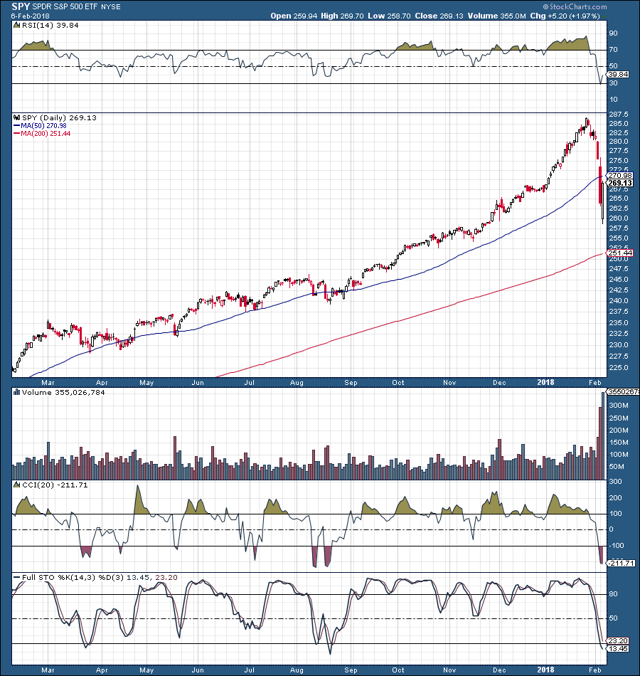
If You’re Not Scared of the Big Bad Bear Buy The Dip!
Disclaimer: This article expresses solely my opinions, is produced for informational purposes only, and is not a recommendation to buy or sell any securities. Investing comes with risk to loss of principal. Please always conduct your own research and consider your investment decisions very carefully.
To receive real time updates, and get more information about this idea as well as other topics we discuss visit our Albright Investment Group trading community. Join us and receive access to exclusive content, trade triggers, trading strategies, price action alerts, and price targets. The value adding features are available to members of our community and are not discussed in public articles.
Disclosure: I am/we are short VXX.
I wrote this article myself, and it expresses my own opinions. I am not receiving compensation for it (other than from Seeking Alpha). I have no business relationship with any company whose stock is mentioned in this article.
[ad_2]
Source link















